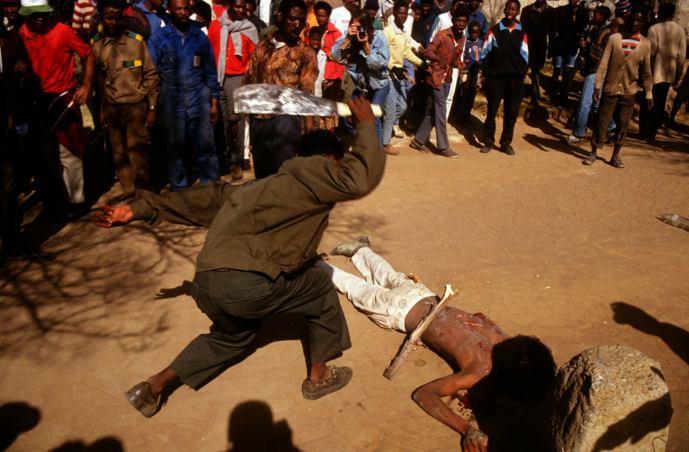The photograph above was taken in 1992 in South Africa. It appeared this past week in a NYT slide show featuring the photography of Joao Silva and commemorating the first democratic elections in post-Apartheid South Africa. It is a brutal image of a public execution, more vigilante justice than state sanctioned, but that seems to be a minor distinction under the circumstances. What caught my attention, however, was less the savage cruelty and inhumanity of the scene itself, but the caption that read “Residents killed a man wrongly accused of being an Inkatha Freedom Party supporter.”
In the late 1980s and early 1990s the Inkatha Freedom Party (IFP) was a rival to the African National Congress (ANC) and had allegedly collaborated with the South African police force in perpetrating the Boipatong Massacre which resulted in the death and maiming of 40+ citizens. The police were exonerated in a public trial in 1993, but a number of IFP supporters were found guilty. I don’t know what evidence there is to suggest that the man in the photograph was “wrongly accused,” but it hardly seems to matter, as the recognition of the very possibility that it might be a “wrongful” execution underscores the sheer brutality of the act itself.
What made that caption stand out for me was the report issued this past week by the National Academy of Science (NAS) which reports that based on a statistical model of the people actually exonerated of capital crimes subsequent to sentencing and prior to execution, 4.1% of the death sentences issued in the United States are wrongly determined. The report also concludes that this number is a conservative estimate of wrongful convictions. That means that of the 1,348 men and women executed since 1977, approximately 54 were in some significant probability innocent of the crimes for which they were accused. Of course we don’t photograph executions in the United States, or if we do we don’t distribute them for public consumption. And so the brutality of such killings—even when they are allegedly “justified” or when they “go wrong” as with the recent botched execution in Oklahoma—never receive a public screening. At the best, what we get to see are empty death chambers, bureaucratic portraits of emotionally barren, institutional mechanisms (e.g., here and here) presented almost as if to signal something of the alleged blindness of justice. There are problems with that last assumption as well, as the evidence is compelling that race and gender play a significant role in who is sentenced to death in the United States, but the bigger point here is that when we never see the horror of any execution we are spared the tragedy of viewing a wrongful one. And maybe that is one reason why the NAS report has received so little public attention.
But there is another and perhaps more important point to be made here, and it returns us to the photograph of execution in South Africa. Look closely at the photograph and take notice of the people surrounding the execution. They are not just watching the event, but standing in as witnesses, endorsing it by their participation as spectators. As the caption reads, “residents” killed a man wrongfully accused. Only one resident wields a machete, but the force of the blow being administered is legitimized by the active spectatorship of the residents who both see and are seen as part of the scene. Thirty two states retain execution as a legitimate means of punishing convicted murders and according to a recent PEW Trust poll, 55% of all Americans endorse capital punishment. Those are numbers and not photographs, of course, but as with the residents who participated in the execution by witnessing it, so too do we as an American people bear responsibility for the brutality of every single wrongful execution, however much it may only remain a probability.
Photo Credit: Joao Silva/New York Times

In the nineties I switched from one bank (Citibank) to another because it fired its entire janitorial staff in order to hire P/T staff w/no benefits for less pay in order to increase their profit- 2 weeks later the bank I switched to was found to have ties to the Russian mob.
Today, I wear shoes and clothes made in sweat shops, my food comes from animals that have been tortured their very short lives or picked by people who are habitually taken advantage of, recently I discovered that the pittance I have in a 401k goes to support private jails, my tax dollars support the largest military/industrial complex in the world, I’m typing on a device made from materials gathered from the poorest of countries often under the bloodiest of circumstances that when finally disposed go back to other dirt poor countries to further poison their environment and ultimately themselves. And we all continue to profit by continuing to use fossil fuels and therefore condemning the very air, food and water that we breathe, eat and drink.
I could go on- but I swear I was trying to make a point here…